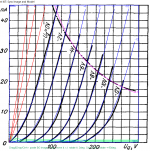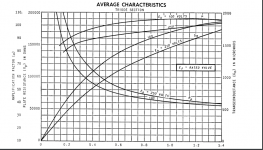In looking at the tube data for this device it list a gain coeficent of 20 +_ 4 . I assume this the same as the mu. But are they saying the gain varies from 16 to 24 from tube to tube or does the gain vary depending on the plate voltage .
The tolerance unit to unit is 20%, under the specified operating conditions.
Mu will always vary somewhat with operating conditions, even if theoretically it does not.
Mu will always vary somewhat with operating conditions, even if theoretically it does not.
Last edited:
Take this 6AV6 (like the 12AX7A) data sheet for example. It has a very nice graph of rp, gm, and mu.
Notice how mu varies with voltage and current, even if theoretically it is constant.
Of course, the filament voltage also affects the parameter values, including mu.
https://frank.pocnet.net/sheets/093/6/6AV6.pdf
Notice how mu varies with voltage and current, even if theoretically it is constant.
Of course, the filament voltage also affects the parameter values, including mu.
https://frank.pocnet.net/sheets/093/6/6AV6.pdf
Last edited:
Характериограф От Lnx - Страница 9 - Ламповая техника - Форум по радиоэлектронике
You can see the actual trace Mu (~20) of the above is quite different from each other as well as from u (~17) of other published curves.
You can see the actual trace Mu (~20) of the above is quite different from each other as well as from u (~17) of other published curves.
Attachments
Take this 6AV6 (like the 12AX7A) data sheet for example. It has a very nice graph of rp, gm, and mu.
Notice how mu varies with voltage and current, even if theoretically it is constant.
Of course, the filament voltage also affects the parameter values, including mu.
https://frank.pocnet.net/sheets/093/6/6AV6.pdf
mu = gm*rp, but since gm varies with cathode currents, and rp with plate voltage, it followed that gm can vary too.....
mu is sensitive to physical tolerances of the position and spacing of the grid wires, so I suspect will only have tight tolerance for physically larger devices and with lower gain.
In theory mu is only sensitive to geometry, so should be stable for any given tube, but of course in practice there are many effects to ruin this simplistic picture, such as thermal expansion and distortions, space charge density effects etc etc.
Dual triodes are much more likely to have good matching of mu than randomly chosen single valves for instance, as they came off the same production line at the same time - they are not just to save space!
In theory mu is only sensitive to geometry, so should be stable for any given tube, but of course in practice there are many effects to ruin this simplistic picture, such as thermal expansion and distortions, space charge density effects etc etc.
Dual triodes are much more likely to have good matching of mu than randomly chosen single valves for instance, as they came off the same production line at the same time - they are not just to save space!
a look at tube datasheets reveal the changes in characteristics as plate voltage, and cathode currents are changed....
Attachments
Last edited:
- Home
- Amplifiers
- Tubes / Valves
- 6n6p MU


